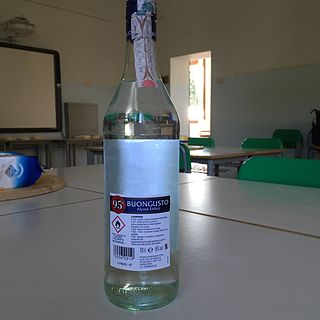Related Research Articles

A birth defect, also known as a congenital disorder, is a condition present at birth regardless of its cause. Birth defects may result in disabilities that may be physical, intellectual, or developmental. The disabilities can range from mild to severe. Birth defects are divided into two main types: structural disorders in which problems are seen with the shape of a body part and functional disorders in which problems exist with how a body part works. Functional disorders include metabolic and degenerative disorders. Some birth defects include both structural and functional disorders.

Fetal alcohol spectrum disorders (FASDs) are a group of conditions that can occur in a person whose mother drank alcohol during pregnancy. Symptoms can include an abnormal appearance, short height, low body weight, small head size, poor coordination, behavioural problems, learning difficulties, and problems with hearing and sight. Those affected are more likely to have trouble with school, the legal system, alcohol, other drugs, and other areas of high risk. The several forms of the condition are: Fetal Alcohol Syndrome (FAS), Partial Fetal Alcohol Syndrome (pFAS), Alcohol-Related Birth Defects (ARBD),Static Encephalopathy, Alcohol-Related Neurodevelopmental Disorder (ARND) and Neurobehavioral Disorder associated with Prenatal Alcohol Exposure (ND-PAE). Some authorities accept only FAS as a diagnosis, seeing the evidence as inconclusive with respect to other types.

Pregnancy, also known as gestation, is the time during which one or more offspring develops inside a woman. A multiple pregnancy involves more than one offspring, such as with twins. Pregnancy usually occurs by sexual intercourse, but can also occur through assisted reproductive technology procedures. A pregnancy may end in a live birth, a spontaneous miscarriage, an induced abortion, or a stillbirth. Childbirth typically occurs around 40 weeks from the start of the last menstrual period (LMP). This is just over nine months —where each month averages 31 days. When using fertilization age it is about 38 weeks. An embryo is the developing offspring during the first eight weeks following fertilization, after which, the term fetus is used until birth. Signs and symptoms of early pregnancy may include missed periods, tender breasts, morning sickness, hunger, and frequent urination. Pregnancy may be confirmed with a pregnancy test.
Environmental toxicants and fetal development is the impact of different toxic substances from the environment on the development of the fetus. This article deals with potential adverse effects of environmental toxicants on the prenatal development of both the embryo or fetus, as well as pregnancy complications. The human embryo or fetus is relatively susceptible to impact from adverse conditions within the mother's environment. Substandard fetal conditions often cause various degrees of developmental delays, both physical and mental, for the growing baby. Although some variables do occur as a result of genetic conditions pertaining to the father, a great many are directly brought about from environmental toxins that the mother is exposed to.
Prenatal development includes the development of the embryo and of the foetus during a viviparous animal's gestation. Prenatal development starts with fertilization, in the germinal stage of embryonic development, and continues in fetal development until birth.

Nutrition and pregnancy refers to the nutrient intake, and dietary planning that is undertaken before, during and after pregnancy. Nutrition of the fetus begins at conception. For this reason, the nutrition of the mother is important from before conception as well as throughout pregnancy and breast feeding. An ever-increasing number of studies have shown that the nutrition of the mother will have an effect on the child, up to and including the risk for cancer, cardiovascular disease, hypertension and diabetes throughout life.
Neurodevelopmental disorders are a group of disorders that affect the development of the nervous system, leading to abnormal brain function which may affect emotion, learning ability, self-control, and memory. The effects of neurodevelopmental disorders tend to last for a person's lifetime.

Alcohol has a number of effects on health. Short-term effects of alcohol consumption include intoxication and dehydration. Long-term effects of alcohol include changes in the metabolism of the liver and brain, several types of cancer and alcohol use disorder. Alcohol intoxication affects the brain, causing slurred speech, clumsiness, and delayed reflexes. Alcohol stimulates insulin production, which speeds up glucose metabolism and can result in low blood sugar, causing irritability and possibly death for diabetics. There is an increased risk of developing an alcohol use disorder for teenagers while their brain is still developing. Adolescents who drink have a higher probability of injury including death.
There is no global consensus on recommended maximum intake of the drug alcohol. The guidelines provided by health agencies of governments are varied and are shown below. These recommendations concerning maximum intake are distinct from any legal restrictions that may apply in those countries. The American Heart Association recommends that those who do not already consume alcoholic beverages should not start doing so because of the negative long-term effects of alcohol consumption.

Binge drinking, or heavy episodic drinking, is drinking alcoholic beverages with an intention of becoming intoxicated by heavy consumption of alcohol over a short period of time, but definitions vary considerably.
Drugs and medications should be avoided while pregnant. Women should speak to their doctor or healthcare professional before starting or stopping any medications while pregnant. Tobacco, alcohol, marijuana, and illicit drug use while pregnant may be dangerous for the unborn baby and may lead to severe health problems and/or birth defects. Even small amounts of alcohol, tobacco, and marijuana have not been proven to be safe when taken while pregnant. In some cases, for example, if the mother has epilepsy or diabetes, the risk of stopping a medication may be worse than risks associated with taking the medication while pregnant. The mother's healthcare professional will help make these decisions about the safest way to protect the health of both the mother and unborn child. In addition to medications and substances, some dietary supplements are important for a healthy pregnancy, however, others may cause harm to the unborn child.
Neonatal withdrawal or neonatal abstinence syndrome (NAS) or neonatal opioid withdrawal syndrome (NOWS) is a withdrawal syndrome of infants after birth caused by in utero exposure to drugs of dependence, most commonly opioids. Common signs and symptoms include tremors, irritability, vomiting, diarrhea, and fever. NAS is primarily diagnosed with a detailed medication history and scoring systems. First-line treatment should begin with non-medication interventions to support neonate growth, though medication interventions may be used in certain situations.

Developmental toxicity is any structural or functional alteration, reversible or irreversible, which interferes with homeostasis, normal growth, differentiation, development or behavior, and which is caused by environmental insult. It is the study of adverse effects on the development of the organism resulting from exposure to toxic agents before conception, during prenatal development, or post-natally until puberty. The substance that causes developmental toxicity from embryonic stage to birth is called teratogens. The effect of the developmental toxicants depends on the type of substance, dose and duration and time of exposure.

A high-risk pregnancy is one where the mother or the fetus has an increased risk of adverse outcomes compared to uncomplicated pregnancies. No concrete guidelines currently exist for distinguishing “high-risk” pregnancies from “low-risk” pregnancies, however there are certain studied conditions that have been shown to put the mother or fetus at a higher risk of poor outcomes. These conditions can be classified into three main categories: health problems in the mother that occur before she becomes pregnant, health problems in the mother that occur during pregnancy, and certain health conditions with the fetus.
A pre-existing disease in pregnancy is a disease that is not directly caused by the pregnancy, in contrast to various complications of pregnancy, but which may become worse or be a potential risk to the pregnancy. A major component of this risk can result from necessary use of drugs in pregnancy to manage the disease.

June Oscar AO is an Australian Aboriginal woman of Bunuba descent, Indigenous rights activist, community health and welfare worker, film and theatre producer, and Aboriginal and Torres Strait Islander Social Justice Commissioner. Oscar is best known for her fight against Fetal Alcohol Spectrum Disorder (FASD) and work in improving the lives of Aboriginal people in remote communities. In 2007, she led the successful campaign for alcohol restrictions in the Kimberley town of Fitzroy Valley.

Alcohol use in pregnancy includes use of alcohol at any time during gestation, including the time before a mother-to-be is aware that she is pregnant. Alcohol use at some point during pregnancy is common and appears to be rising in prevalence.

Alcohol packaging warning messages are warning messages that appear on the packaging of alcoholic drinks concerning their health effects. They have been implemented in an effort to enhance the public's awareness of the harmful effects of consuming alcoholic beverages, especially with respect to foetal alcohol syndrome and alcohol's carcinogenic properties. In general, warnings used in different countries try to emphasize the same messages. Such warnings have been required in alcohol advertising for many years, although the content of the warnings differ by nation.
Elizabeth Jane Elliott is an Australian clinician scientist. She is a Member of the Order of Australia (AM), for services to paediatrics and child health, as well as an Elected Fellow of the Australian Academy of Health and Medical Science (AAHMS), Fellow of the Royal Society of NSW, and Fellow of the Academy of Child and Adolescent Health. She was the first female to win the James Cook Medal, awarded by the Royal Society of NSW for contributions to human welfare. She is a Distinguished Professor of paediatrics at the University of Sydney and a Consultant Paediatrician at the Sydney Children’s Hospitals Network, Westmead, and regarded as a "pioneer in fetal alcohol spectrum disorder, advocacy and patient care".
Ann Roth Pytkowicz Streissguth is a scientist known for her groundbreaking research on fetal alcohol spectrum disorder. She is an Endowed Professor Emeritus and Founding Director of the Fetal Alcohol Drug Unit at the University of Washington School of Medicine.
References
- ↑ "CDC - FASD, Training and Education - NCBDDD". Cdc.gov. 2013-04-15. Retrieved 2013-08-30.
- ↑ "Ask the expert: Maternal drinking and FASD - Chicago Tribune". Articles.chicagotribune.com. 2012-09-26. Retrieved 2013-08-30.
- ↑ "Commentary: Creating a Circle of Hope to Prevent Fetal Alcohol Syndrome Disorders | The Partnership at". Drugfree.org. Retrieved 2013-08-30.
- ↑ "NOFAS – Board & Staff". Nofas.org. 1996-01-09. Retrieved 2013-08-30.